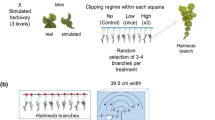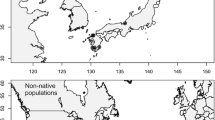Summary
Structural features of marine macrophytes are generally believed to act as defences against herbivores by reducing the ability of herbivores to consume the plants. Thallus form and calcification in particular have been considered structural defences that act by reducing the probability of consumption of tissue by herbivores. Studies directly measuring the mechanical resistance of a variety of marine algae (tropical and temperate) to herbivores of two important feeding types, rasping herbivores (docoglossan limpets) and a biting herbivore (an herbivorous crab), do not support this hypothesis. I suggest that thallus form and calcification may play a more important role in minimizing the impact of herbivores by reducing the probability of subsequent tissue loss due to herbivore-induced damage. For some algal species, tissue lost subsequent to herbivore damage may greatly exceed loss due to direct consumption by herbivores. I suggest that calcification and thallus properties resulting in preferential tear directions reduce the probability of tissue loss subsequent to herbivore damage rather than prevent herbivores from removing tissue as has been suggested in the past.
Similar content being viewed by others
References
Biedka, R.F., Gosline, J.M. and DeWreede, R.E. (1987) Biomechanical analysis of wave-induced mortality in the marine algaPterygophora californica.Mar. Ecol. Prog. Ser. 36, 163–70.
Black, R. (1976) The effects of grazing by the limpet,Acmaea insessa, on the kelpEgregia laevigata, in the intertidal zone.Ecology 57, 265–77.
Borowitzka, M.A. (1982) Mechanisms in algal calcification.Prog. Phycol. Res. 1, 137–77.
Brasier, M. (1986) Why do lower plants and animals biomineralize?Paleobiology 12, 241–50.
Denny, M.W. (1988)Biology and Mechanics of the Wave-swept Environment. Princeton University Press, Princeton, NJ.
Dromgoole, F.I. (1980) Desiccation resistance of intertidal and subtidal algae.Bot. Marina 23, 149–59.
Flugel, E. (1977)Fossil Algae. Recent Results and Discoveries. Springer-Verlag, Heidelberg.
Gaines, S.D. and Lubchenco, J. (1982) A unified approach to marine plant—herbivore interactions. II. Biogeography.Ann. Rev. Ecol. Syst 13, 111–38.
Gordon, J.E. (1968)The New Science of Strong Materials. Penguin Books Ltd, Harmondsworth, UK.
Hawkins, S.J. and Hartnoll, R.G. (1983) Grazing of intertidal algae by marine invertebrates.Oceanogr. Mar. Biol. Ann. Rev. 21, 195–282.
Hay, M.E. and Fenical, W. (1988) Marine plant—herbivore interactions: the ecology of chemical defense.Ann. Rev. Ecol. Sys. 19, 111–45.
Johansen, H.W. (1981)Coralline Algae, A First Synthesis. CRC Press, Inc., Boca Raton, Florida.
Johnson, C.R. and Mann, K. (1986a) The crustose coralline algae,Phymatolithon Foslie, inhibits the overgrowth of seaweeds without relying on herbivores.J. Exp. Mar. Biol. Ecol. 96, 127–46.
Johnson, C.R. and Mann, K. (1986b) The importance of plant defense abilities to the structure of subtidal seaweed communities: the kelpLaminaria longicruris de la Pylaie survives grazing by the snailLacuna vincta (Montagu) at high population densities.J. Exp. Mar. Biol. Ecol. 97, 231–67.
Koehl, M.A.R. and Wainwright, S.A. (1977) Mechanical adaptations of a giant kelp.Limnol. Oceanogr. 22, 1067–71.
Littler, M.M. and Littler, D.S. (1980) The evolution of thallus form and survival strategies in benthic marine macroalgae: field and laboratory tests of a functional form model.Am. Nat. 116, 25–44.
Littler, M.M., Littler, D.S. and Taylor, P.R. (1983) Evolutionary strategies in a tropical barrier reef system: functional-form groups of marine macroalgae.J. Phycol. 19, 229–37.
Lubchenco, J. and Gaines, S.D. (1981) A unified approach to marine plant—herbivore interactions. I. Populations and communities.Ann. Rev. Ecol. Sys. 12, 405–37.
Norris, J.N. and Fenical, W. (1982) Chemical defense in tropical marine algae. InThe Atlantic Barrier Reef Ecosystem at Carrie Bow Cay, Belize, I. Structure and Communities (K. Ruetzler and I.G. Macintyre, eds,) Vol. 12, pp. 417–31.Smithsonian Contributions in Marine Science, Washington, DC
Padilla, D.K. (1982) MS Thesis, Oregon State University, Corvallis, OR.
Padilla, D.K. (1985) Structural resistance of algae to herbivores. A biomechanical approach.Mar. Biol. 90, 103–9.
Padilla, D.K. (1987) PhD Dissertation, The University of Alberta, Edmonton, Alberta.
Padilla, D.K. (1989a) Structural defenses of algae: calcification and form and resistance to limpets.Ecology 70, 835–42.
Padilla, D.K. (1989b) Rip-stop in marine algae: reducing secondary tissue loss.Am. Zool. 28, 187A.
Paul, V.J. and Fenical, W. (1983) Isolation of halimedatrial: chemical defense adaptation in the calcareous reef-building algaHalimeda.Science 221, 747–9.
Paul, V.J. and Hay, M.E. (1986) Seaweed susceptibility to herbivory: chemical and morphological correlates.Mar. Ecol. Prog. Ser. 33, 255–64.
Paul, V.J. and Van Alstyne, K.L. (1988) Antiherbivore defenses inHalimeda.Proc. 6th Int. Coral Reef Symp. Australia 3, 133–8.
Santelices, B., Castilla, J.C., Cancino, J. and Schmiede, P. (1980) Comparative ecology ofLessonia nigrescens andDurvillaea antarctica (Phaeophyta) in central Chile.Mar. Biol. 59, 119–32.
Simkiss, K. (1977) Biomineralization and detoxification.Calc. Tissue Res. 24, 199–200.
Steneck, R.S. (1982) A limpet-coralline alga association: adaptations and defenses between a selective herbivore and its prey.Ecology 63, 507–22.
Steneck, R.S. (1983) Escalating herbivory and resulting adaptive trends in calcareous algal crusts.Paleobiology 9, 44–61.
Steneck, R.S. and Watling, L. (1982) Feeding capabilities of herbivorous molluscs: a functional group approach.Mar. Biol. 68, 299–319.
Van Alstyne, K.L. (1988) Herbivore grazing increasing polyphenolic defences in the intertidal brown algaFucus distichus.Ecology 69, 655–64.
Vine, P.J. (1974) Effects of algal grazing and aggressive behaviour of the fishesPomacentrus lividus andAcanthurus sokal on coral-reef ecology.Mar. Biol. 24, 131–6.
Vogel, S. (1981) Life in Moving Fluids, Willard Grant Press, Boston, MA, USA.
Wainwright, S.A., Biggs, W.D., Currey, J.D. and Gosline, J.M. (1976)Mechanical Design in Organisms. Wiley Press, New York.
Wanders, J.B.W. (1977) The role of benthic algae in the shallow reef of Curacao (Netherlands Antilles) III: the significance of grazing.Aquat. Bot. 3, 357–90.
Zar, J.H. (1974)Biostatistical Analysis. Prentice-Hall, Englewood Cliffs, NJ, USA.
Author information
Authors and Affiliations
Rights and permissions
About this article
Cite this article
Padilla, D.K. Rip stop in marine algae: Minimizing the consequences of herbivore damage. Evol Ecol 7, 634–644 (1993). https://doi.org/10.1007/BF01237826
Issue Date:
DOI: https://doi.org/10.1007/BF01237826




